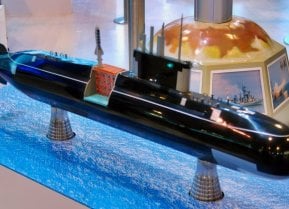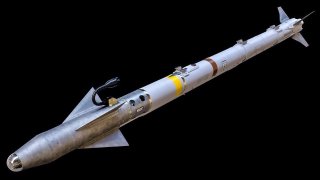Why the U.S. Military Needs the Sidewinder Missile
Developed at a turning point in air-to-air combat, the AIM-9 Sidewinder missile was the world’s first infrared-guided — or heat-seeking — missile, forever changing not only the dynamics of dog fighting, but the ways in which combat aircraft are designed, built, and employed in war.
Developed at a turning point in air-to-air combat, the AIM-9 Sidewinder missile was the world’s first infrared-guided — or heat-seeking — missile, forever changing not only the dynamics of dog fighting, but the ways in which combat aircraft are designed, built, and employed in war. But most surprising of all is that this game-changing missile wasn’t developed with backing from the U.S. military… but rather, in spite of it.
The air combat of World War II was largely dominated by daring pilots flying in close quarters with the enemy in an effort to engage them with a variety of onboard cannons. Air-to-air rockets had proven effective in limited use during World War I against observation balloons and again in World War II against bombers, but the unguided nature of these weapons severely limited their range and efficacy.
The birth of air-to-air missiles was all about radar-guidance
By the end of World War II, the advent of radar had made the prospect of fielding guided air-to-air missiles a reality. By 1947, both the U.K. and the U.S. were quickly developing a new bevy of radar-guided weapons like the U.K.’s Fairey Fireflash and America’s AAM-A-1 Firebird. These early air-to-air missiles were complex pieces of equipment — which meant they were difficult and expensive to produce.
But physicist William B. McLean, a Navy physicist at the U.S. Naval Ordnance Test Station (NOTS) in the Mojave Desert — a man whose professional responsibilities notably did not include new weapon development — thought he knew better than the prevailing wisdom of the day… And despite the Navy’s disinterest and a fair bit of harassment from his peers, he set out to prove it.
McLean’s Hobby Shop
One year before contracts were awarded for these early radar-hunting missiles, William B. McLean and his team were working with lead-sulfide proximity fuzes that were designed to be sensitive to infrared radiation (heat). Well aware of developmental radar-guided missiles and their complexity, McLean reasoned that if you could make a fuse that detonated when it sensed infrared radiation, it might also be possible to develop a guidance system that used that same heat-sensing ability to adjust course mid-flight.
There was just one problem… McLean had no experience designing these sorts of weapons.
McLean earned his bachelor’s and master’s degrees, as well as his Ph.D., from the California Institute of Technology, before studying nuclear physics as a fellow at the University of Iowa and eventually accepting a position designing weapon fuses for the National Bureau of Standards in 1941. At the time his heat-seeking missile concept began to take shape in his mind in 1946, McLean had only worked at the Naval Ordnance Test Station (now the Naval Weapons Center) at China Lake for about a year.
And as you might have guessed, the brass at China Lake weren’t particularly interested in the guy in charge of their fuses offering up grandiose ideas about how to create new air-to-air missiles.
McLean, however, fervently believed that his concept had wings, and he wasn’t the only one. Before long, his subordinates were similarly invested in the idea, and they began stealing time here and there to spend on the concept. It didn’t make McLean or his team very popular with their peers, who saw his missile idea as a waste of time. As a result, the office space occupied by the young physicist and his team earned the derisive nickname of “McLean’s Hobby Shop.”
It’s easy to build something complicated. It’s hard to build something simple
McLean and his team continued working on his infrared-guided missile here and there for years before it finally manifested in something that could be tested. Finally, they produced the world’s first infrared guidance system that was small enough to be housed within the body of a standard 5″ air-to-ground rocket.
“I personally spent nearly three years [just] considering possibilities,” McLean later recalled. “It is easy to build something complicated; it’s hard to build it so that it’s simple.”
The system used a parabolic mirror spinning gyroscopically at 4,200 rpm inside a transparent nosecone mounted on the end of the rocket. As the mirror span, the system assessed the distance of an infrared signal’s reflection from the axis of spin to determine the angle at which the rocket was off from reaching its target. The system used the same lead-sulfide detector McLean had used in proximity fuzes as the center point. In turn, the system controlled the rocket (now missile) via electromagnets that would turn its guide fins.
Navy pilot Wally Schirra, who had a MiG-kill under his belt and would later become an astronaut, described the unusual device at the time as a “dome-shaped device, made of glass….a man-made eyeball.”
“I was a cigarette smoker in those days, and I had one in my hand. As I crossed the room, I noticed that the eyeball was tracking me,” Schirra recalled.
Perhaps the most important engineering feat McLean and his team incorporated into the design was the ability to use the targeting system not to aim directly at a target, but rather at where the target would be when its path intersected with the missile, making it possible to actually hit the fast-moving jet-powered fighters that had been coming into service.
Hunting airplanes like a pit viper hunts prey
In 1950, McLean named his weapon Sidewinder, after the venomous horn vipers that inhabit deserts like the Mojave. These snakes have temperature-sensitive organs on either side of their heads that can detect infrared radiation, making them extremely effective hunters of warm-blooded prey.
McLean’s Sidewinder didn’t just offer a new approach to engaging enemy aircraft, it was also a simpler design than the radar-guided missiles making their way toward service.
The original, and somewhat rough in finish, Sidewinder Missile measured just 10 feet long, about five inches across, and weighed in at only 160 pounds. That was about half the weight of the U.K.’s Fireflash missile and less than a third the weight of America’s Firebird. Best of all, the weapon had just 24 moving parts, making it cheap to produce and extremely reliable.
It’s important to remember that in 1950, when McLean showed his creation to General Parsons, the world’s first commercial computer, the UNIVAC I mainframe, was still a year away… and would weigh more than 16,000 pounds. The self-guided engine-hunting flying robot McLean invented predates Super Glue and radial tires. McLean’s Sidewinder was steering itself using electromagnets before Chrysler invented power steering for cars. The problem was… the Navy was still far from convinced.
As Dr. William H. Pickering, the longest-serving director of NASA’s Jet Propulsion Laboratory wrote about the Sidewinder and its inventor in 1985:
“The technical problems were solvable. The bureaucratic problems were more difficult. Bill was faced with the problem of convincing the Navy that Sidewinder was a useful weapon system,” he recalled.
“As a member of the NOTS Scientific Advisory Board at the time, I feel it is not too much of an exaggeration to say that Bill built Sidewinder in spite of the Navy.”
That same year, McLean presented his mad invention to Admiral William “Deak” Parsons, who had not only worked in the Manhattan Project but who was the actual weaponeer aboard the Enola Gay B-29 as it dropped the atomic bomb on Hiroshima in 1945. Despite the derision McLean had been faced with up to that point, Parsons immediately recognized the incredible potential the weapon had to offer.
The Sidewinder goes to war over the Taiwan Strait
Within three years, the first AIM-9A Sidewinder missile was undergoing test launches, and by 1956, the first production Sidewinders, dubbed AIM-9Bs, were already heading to the fleet.
Just two years later, Sidewinders would score their first kills at the hands of Taiwanese pilots in a massive dogfight against Chinese forces.
China would send 126 MiG-15s and MiG-17s across the Taiwan Strait while Taiwan could muster just 48 American-sourced F-86 Sabres to intercept. The MiGs were faster and had a higher service ceiling, but the Sabres were carrying brand-new American AIM-9 Sidewinder missiles. As the fighting broke out, China’s jets took to higher altitudes in order to exploit the Sabres’ lower operational ceiling and their need to close to within just a few hundred feet to engage with guns.
Instead, the Sabres unleashed salvos of Sidewinder missiles, quickly downing six MiGs from distances as great as 9,000 feet. As the Chinese jets scrambled to adjust, three more were shot down by Sabre cannons as they flew into lower altitudes.
The Chinese fighters made a hasty retreat and not a single Sabre was lost in the skirmish. Just 12 years after McLean had begun to form his crazy idea it had already changed the course of a conflict on the other side of the globe.
Chief of Naval Operations Admiral Arleigh A. Burke, the namesake for today’s class of American destroyers, has been quoted as saying that nothing since the atomic bomb “had done so much for the Navy” as the Sidewinder missile — and that holds true to this day.


